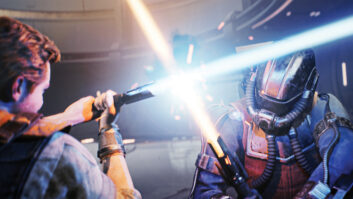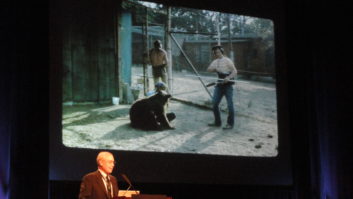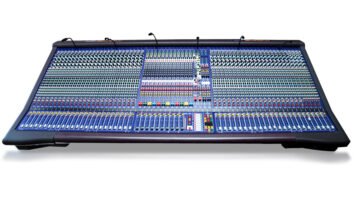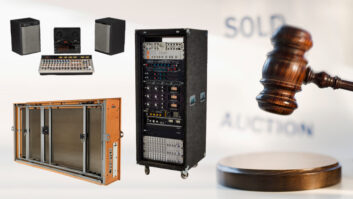Phenomenon, franchise, lifestyle — call it what you like. The Star Trek television series and roster of movies — not to mention books, the Las Vegas theme park and merchandising — have created legions of devoted Trekkies who are notoriously picky about their obsession. So when it turned out that both a fresh perspective and a continuum were needed for film number 10, Paramount’s Star Trek: Nemesis, the post-production sound crew had to devise a delicate balancing act.
“When I found out I was going to do the project, I went back and looked at everything from nine on down,” says supervising sound editor Alan Murray, a veteran of the first Star Trek movie. Murray enlisted the help of friend George Watters (who worked on the films up until number five) and Jim Wolvington (who’d worked on six through nine) at the behest of co-producer Rick Berman.
“The producers are, naturally, very protective of the Star Trek sound,” he continues. “The fan base is huge, and they get e-mails and letters from people saying, ‘What are you doing?’ if they change things. So we were ready with what we thought they wanted. But then we saw the film. It’s a very different Star Trek than has ever been made. It’s dark and action-packed, with tons of gun battles — a real roller-coaster ride. I realized we couldn’t go in a traditional direction. Also, the director, Stuart Baird, wanted this Star Trek to have its own life.”
Murray and his crew found that many long-established Trek sounds, like those for the phasers and the characters’ “transports” between places — which always had a musical base — didn’t work this time. “When I put that kind of sound in, it just seemed wrong,” Murray explains. “What I decided to do was change things but keep the producers apprised of what I was changing. After they started coming over for playback, they jumped right on the bandwagon. They also felt that this movie had to break out of the typical mode — that it dictated a different direction.”
“It’s a bold-sounding dub,” agrees sound effects mixer Frank Montaño. “Stuart wanted to bring an edge to Nemesis that he predicated visually, and that allowed us a lot more freedom. The biggest kick was when we played back each reel and the producers would come in and say, ‘We’ve never done that in a Star Trek before, but it’s good and we like it.’”
Building on the original sounds, effects editor Jason King loaded almost the entire series’ library, along with new sound files, onto a Powerbook and FireWire drives. Even with everything just a few keystrokes away, there was heavy pressure on the team. As is common with CGI effects, visuals sometimes took a radical departure from what they’d looked like at temp dubs. “It was pretty intense at times,” Murray admits. “Some-times, while the director was waiting, we’d be working on a scene we’d never seen before, trying to relate it to the library and what I thought it should sound like.
“There are lots of things in this film that haven’t been seen before in Star Trek: dogfights with five spacecraft doing all sorts of maneuvers, the little dune buggy that flies out of a shuttlecraft. The buggy has wheels, but they didn’t want it to sound like it had an axle and an engine. We used jet whines and a cigarette racing boat with animals behind it to get a multilayered sound. Then the aliens showed up and they also had dune buggies that had to be totally different! Then there’s the climax, with a huge alien ship so big it dwarfs the Enterprise. This project just kept getting bigger and bigger.”
The depth of the sound effects, along with dialog, ADR and composer Jerry Goldsmith’s score, made for a record number of tracks arriving at Universal’s Hitchcock Stage for dubbing. “On one reel, we had something like 1,400 tracks,” recalls Montaño. “Obviously, when you get to the final, with dialog, music and sound effects interwoven, there are times you have to sacrifice and times you take center stage. [Dialog and music mixer] Chris [Jenkins] worked with Stuart a lot on processing dialog, everything from pitch shifting and subharmonic information to a lot of different chambers. They came up with a very interesting-sounding track dialog-wise, which also elevated everything around it.”
“I tend to gravitate to movies that will give me a challenge,” says Murray with a laugh, “and this is definitely one of them. I think we took it to a new degree.”






